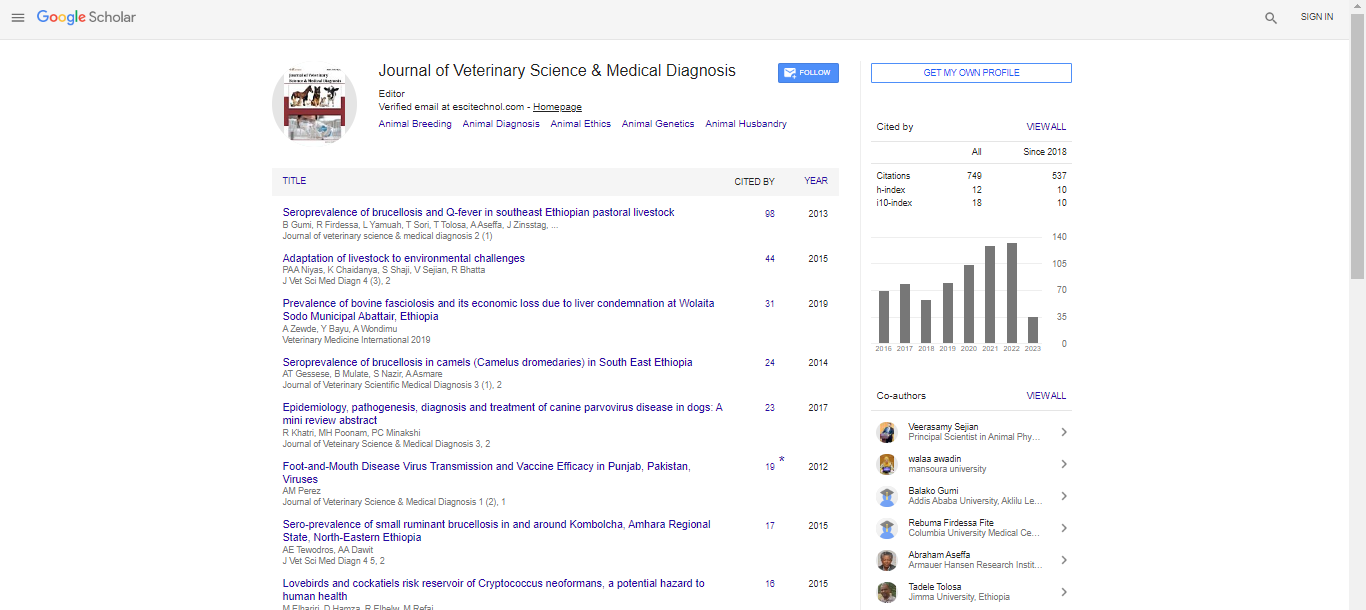Commentary, J Vet Sci Med Diagn Vol: 13 Issue: 2
How Climate Change is Reshaping Animal Production Systems
Mathew Ross*
Department of Animal Science, University of Illinois, Illinois, United States of America
- *Corresponding Author:
- Mathew Ross
Department of Animal Science,
University of Illinois,
Illinois,
United States of America;
E-mail: ross@edu.ac.us
Received date: 13 March, 2024, Manuscript No. JVSMD-24-154228;
Editor assigned date: 15 March, 2024, PreQC No. JVSMD-24-154228 (PQ);
Reviewed date: 29 March, 2024, QC No. JVSMD-24-154228;
Revised date: 09 April, 2024, Manuscript No. JVSMD-24-154228 (R);
Published date: 16 April, 2024, DOI: 10.4172/2325-9590.1000090
Citation: Ross M (2024) How Climate Change is Reshaping Animal Production Systems. J Vet Sci Med Diagn 13:2.
Description
Climate change is one of the most pressing global challenges of the 21st century and its effects are being felt across all sectors, including agriculture and animal husbandry. Rising temperatures, unpredictable weather patterns and changes in ecosystems are profoundly reshaping animal production systems. These changes not only affect the health and productivity of livestock but also impact the economic viability and sustainability of farming operations. Heat stress also makes animals more susceptible to diseases, as their immune systems weaken under prolonged high temperatures. As such, understanding how climate change is influencing animal production and identifying strategies for adaptation and mitigation are critical for ensuring food security and sustainable agricultural practices in the future.
One of the most direct effects of climate change on animal production systems is the increased incidence of heat stress. Rising temperatures can cause livestock, especially heat-sensitive species such as dairy cows, poultry and pigs, to experience thermal stress. This is particularly problematic in intensive farming systems where animals are confined to small spaces, further exacerbating the spread of infectious diseases. This affects their overall health and productivity, leading to decreased milk yields, reduced fertility and slower growth rates and, in severe cases, death. For example, during hot weather, cows may reduce feed intake to lower their body temperature, which results in lower milk production. In addition, heat stress can reduce reproductive efficiency, as it disrupts the estrus cycles of cows and the mating behaviour of bulls.
Climate change is also altering precipitation patterns, leading to more frequent droughts and floods. These changes in water availability are particularly critical for animal production, as livestock require consistent access to clean water for drinking and cooling. In many regions, water shortages caused by prolonged droughts can lead to the depletion of local water resources, forcing farmers to find alternative sources or invest in costly water management infrastructure. Additionally, water scarcity affects the cultivation of feed crops, further straining the ability to provide adequate nutrition for livestock.
Climate change is also altering the geography and seasonal patterns of livestock diseases. Warmer temperatures and changes in humidity are favourable conditions for the spread of pathogens and parasites that affect animals. For example, the range of insect vectors like mosquitoes and ticks, which transmit diseases such as African trypanosomiasis and Lyme disease, is expanding due to warmer temperatures. Additionally, warmer winters may allow pests to survive in regions where they were previously eradicated by cold temperatures, leading to an increase in parasite infestations and related health issues in livestock. As the availability and cost of feed change due to climate impacts, there may also be disruptions in the availability of essential forage crops.
In conclusion, climate change is significantly reshaping animal production systems worldwide. Rising temperatures, altered precipitation patterns and the spread of new diseases are all posing serious challenges to livestock health, productivity and the economic viability of farming. This can result in higher feed prices, making animal production less economically viable for farmers. In response, some farmers may have to adjust their livestock numbers or shift to more drought-tolerant species. However, by adopting innovative management practices, improving animal genetics and integrating climate-resilient strategies, the agricultural sector can mitigate the impacts of climate change and help ensure sustainable food production.
 Spanish
Spanish  Chinese
Chinese  Russian
Russian  German
German  French
French  Japanese
Japanese  Portuguese
Portuguese  Hindi
Hindi 
